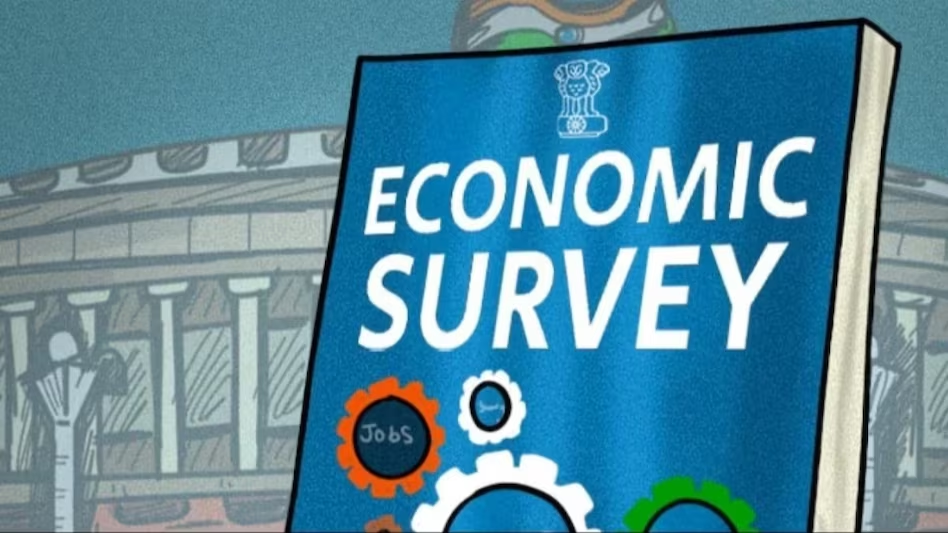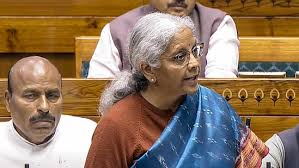The Economic Survey for the fiscal year 2024-2025 was tabled in Parliament today by Finance Minister Nirmala Sitharaman, offering a comprehensive analysis of India’s economic performance over the past year and setting the tone for the upcoming Union Budget. Authored by Chief Economic Adviser V. Anantha Nageswaran, the survey provides insights into GDP growth projections, foreign investment trends, and market stability, while also addressing challenges such as inflation, market volatility, and global economic headwinds.

Table of Contents
GDP Growth Forecast: A Cautious Optimism
The Economic Survey projects India’s GDP growth at 6.3% to 6.8% for the fiscal year 2025-2026, following an estimated 6.4% growth in 2024-2025. This marks a slowdown from previous years but remains one of the highest among major economies. The forecast underscores steady domestic demand, a resilient services sector, and increased infrastructure investments as key drivers of economic momentum. However, it also acknowledges external risks, including geopolitical uncertainties, global trade disruptions, and fluctuating commodity prices.
“While India’s growth trajectory remains strong, a prudent approach is necessary to navigate potential shocks from the global economy. Strategic policy interventions will be crucial in sustaining long-term economic resilience,” stated Nageswaran during the report’s presentation.

Investment and Foreign Direct Investment (FDI) Trends
One of the notable highlights of the Economic Survey is the resurgence in Foreign Direct Investment (FDI), which recorded inflows of $55.6 billion in the current fiscal year. This increase signals renewed confidence among global investors in India’s economic stability and business environment.
The government’s push for ease of doing business, digitization, and production-linked incentives (PLI) schemes has played a crucial role in attracting investments across key sectors, including manufacturing, renewable energy, and technology. Economic Survey However, the survey also points out that certain regulatory hurdles and policy unpredictability need to be addressed to further enhance investor confidence.
Retail Investor Boom and Market Volatility Risks
A striking trend highlighted in the survey is the unprecedented surge in retail investor participation in India’s equity markets. Data shows that the number of monthly active retail investors on the National Stock Exchange (NSE) increased from 3.2 million in January 2020 to a record 14 million in November 2024.
This retail boom has contributed significantly to household wealth creation, with a cumulative increase of ₹40 trillion in domestic stock holdings. However, the survey also raises concerns about potential risks. “While the rise in retail participation has deepened financial inclusion, Economic Survey it has also exposed small investors to higher market volatility. A sharp correction could have negative implications on consumer spending and overall economic sentiment,” the report warns.
The survey urges financial regulators to enhance investor awareness programs and ensure that risk mitigation measures are in place to prevent large-scale losses in case of sudden market downturns.
Inflation and Monetary Policy Outlook
India has managed to keep inflation in check despite global commodity price fluctuations, with the Consumer Price Index (CPI) inflation averaging around 5.4% in 2024-2025. However, concerns persist over rising food prices, fluctuating crude oil costs, and supply chain disruptions.
The Reserve Bank of India (RBI) has maintained a balanced monetary policy approach, ensuring that interest rates remain supportive of growth while keeping inflationary pressures under control. The survey recommends that the RBI continue to adopt a calibrated stance, with flexibility to adjust rates in response to inflation trends and Economic Survey conditions.
Manufacturing and Infrastructure Growth
The ‘Make in India’ initiative and infrastructure expansion programs continue to be pillars of Economic Survey growth. The survey highlights robust expansion in the manufacturing sector, backed by government-led incentives for domestic production and export competitiveness.
Major infrastructure projects, including highway expansions, port developments, and urban mobility enhancements, have significantly contributed to employment generation and economic productivity. The National Infrastructure Pipeline (NIP) is expected to attract further investments and propel long-term economic growth.
Technology and Digital Economy Transformation
India’s rapid digital transformation remains a key highlight of the survey, with the government emphasizing fintech growth, digital payments, and AI-driven economic applications. The country has witnessed a massive surge in Unified Payments Interface (UPI) transactions, reaching a record ₹120 trillion in transaction volume in 2024.
The report underscores the need for continued investments in cybersecurity, data protection, and digital infrastructure development to sustain momentum in this sector.

Global Economic Outlook and India’s Position
The Economic Survey acknowledges global economic uncertainties, including a potential slowdown in major economies such as the US and China, ongoing geopolitical tensions, and fluctuating commodity markets. However, it asserts that India’s domestic resilience, strong policy frameworks, and demographic advantages will enable it to maintain stable economic growth.
Regulatory Recommendations and Policy Reforms
A key policy recommendation in the Economic survey is the establishment of a formal Regulatory Impact Assessment (RIA) mechanism to enhance transparency in regulatory decision-making. The proposal suggests the creation of an independent regulatory body that would evaluate the impact of new policies before their implementation.
The survey also emphasizes labor market reforms, improved ease of doing business measures, and enhanced public-private partnerships (PPP) for infrastructure development.
Conclusion: Roadmap for India’s Economic Future
The Economic Survey 2025 presents a balanced assessment of India’s economic strengths and potential risks, offering a clear roadmap for sustained growth. While challenges such as market volatility, inflation risks, and global trade uncertainties persist, India’s strong domestic demand, strategic policy initiatives, and expanding digital economy position it well for long-term stability.
As the Union Budget 2025 approaches, policymakers will need to prioritize economic resilience, job creation, and sustainable development initiatives to ensure that the country continues on its high-growth trajectory.
